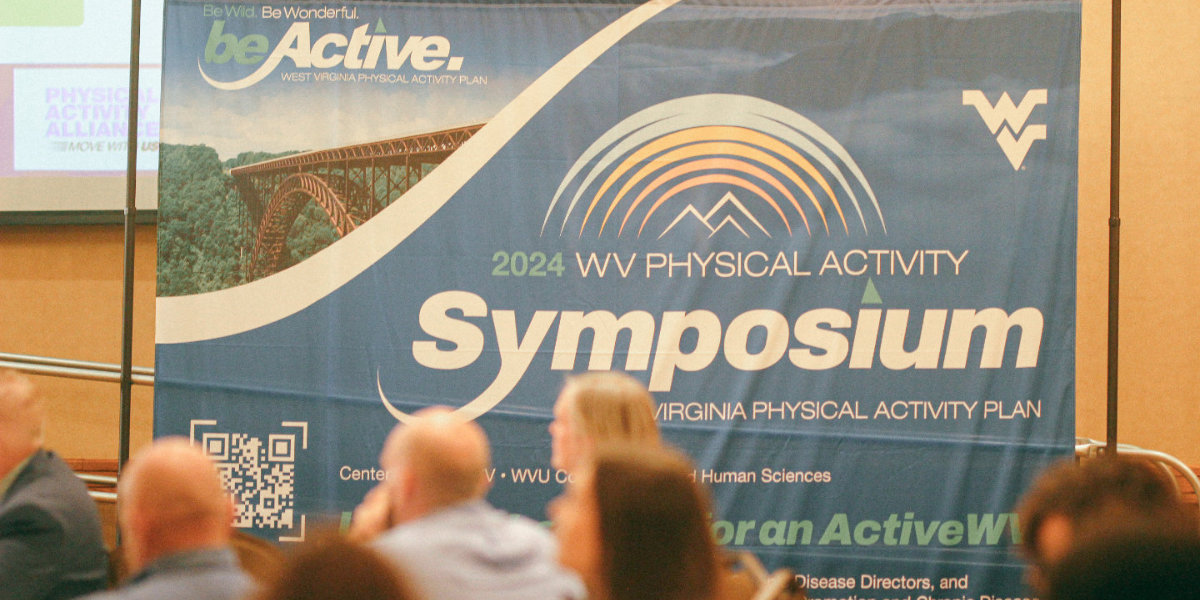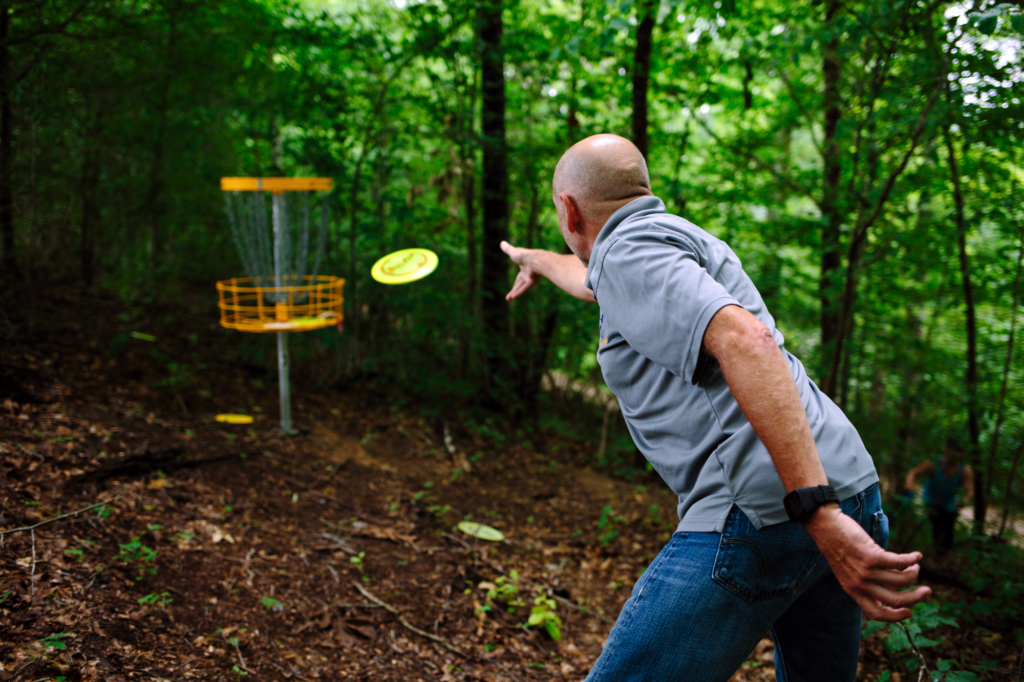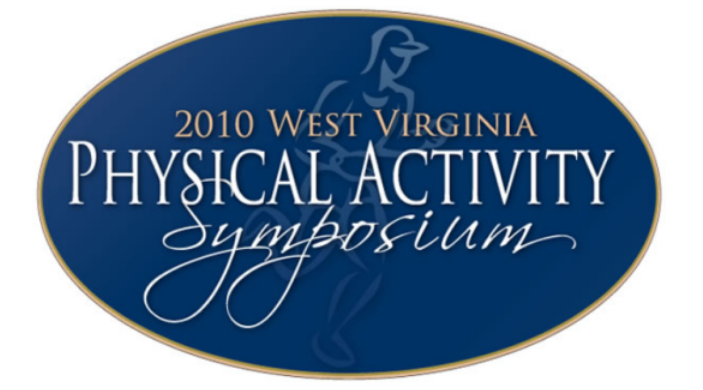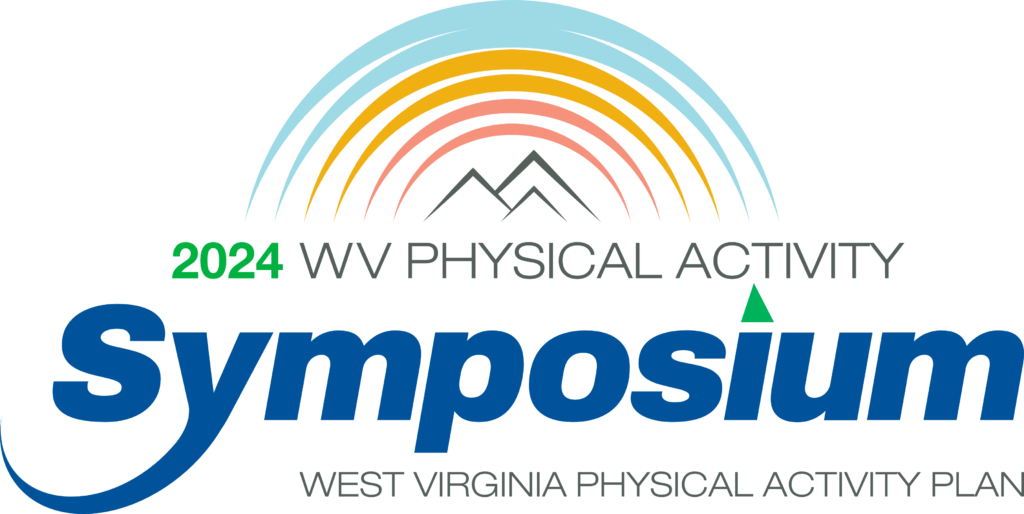
Center for ActiveWV Hosts 2024 Physical Activity Symposium at Stonewall Resort
On May 29, the Center for ActiveWV hosted the “2024 WV Physical Activity Symposium – United Leaders for an ActiveWV” at Stonewall Resort in Roanoke, WV.
West Virginia is wild and wonderful! We live in rural Appalachia with its scenic mountain landscape, welcoming people, and rich cultural heritage. While the people of West Virginia take great pride in the beauty of the natural surroundings and traditions of their Appalachian heritage, a number of disparities related to quality of life persist when compared to other geographic regions of the United States. West Virginia consistently ranks as one of the most disadvantaged in relation to a variety of health indicators including obesity, heart disease, and diabetes. These chronic health problems have multiple contributing biological, psychological, social, and environmental factors. Faced with this reality, West Virginians must continue to work together to reduce risk for chronic disease and manage the associated impact on mortality, morbidity, quality of life, and economic viability.
Physical activity is one of the most important behaviors that West Virginians of all ages can adopt to improve their health status. The relationship between regular physical activity and reduced risk for chronic disease is well established, and small to moderate increases in physical activity offer significant health-related benefits. A little physical activity goes a long way!
Our collective challenge is to find feasible solutions to this public health concern that make a physically active lifestyle the easy choice for every West Virginian. The original version of the West Virginia Physical Activity Plan (The Plan) was released in 2015 and was our first attempt to identify cross-sector strategies and tactics tailored to the unique problems in the mountain state. Modeled on the National Physical Activity Plan, we adapted priorities to fit the specific demographic, cultural, and geographical challenges to physical activity in the mountain state. Since that time, many dedicated professionals have worked to implement programs, community initiatives, legislation, improved access, and policies related to physical activity.


The goal of this revised plan is to increase the physical activity levels of children and adults to meet or exceed the national physical activity recommendations, and to therefore improve the health and quality of life of West Virginians. The achievement of these outcomes is dependent on the establishment of a culture that facilitates physically active lifestyles in every societal sector and geographic region, regardless of the various environmental, social, and individual barriers that people may face.
The target audience for the West Virginia Physical Activity Plan 2030 includes: (a) policy leaders at the local and state levels, (b) key stakeholders representing state and local groups in each societal sector who can assist with plan implementation and evaluation, and (c) West Virginians who can promote physical activity in their communities and advocate for personal, policy, and environmental change.
Mirroring from the National Physical Activity Plan, the West Virginia Physical Activity Plan is organized around ten societal sectors identified as key contributors to promoting physical activity as a public health priority:
From 2022-2024, a substantial revision to The Plan was conducted by a team of professionals and community partners with the Center for ActiveWV at West Virginia University. This multi-step process resulted in the identification of five priority areas that provide the conceptual framework for the West Virginia Physical Activity Plan. The overarching priority areas include:
These five priority areas provide the structural foundation for the specific strategies and tactics that are featured within each societal sector. Using this guide, physical activity advocates can pick up The Plan and immediately identify specific strategies and tactics they are willing to bring to life in their communities. Many dedicated West Virginians are already doing this work, and we have highlighted many of our partners in the Community Engagement section of this Plan.
This ActiveWV 2030 report is organized in the following sections. The Priority Areas section provides a description of each area and a summary of key messages and strategies identified across sectors by priority area. The Sector Strategies and Tactics sections outline sector-specific calls to action statements, strategies, and actionable tactics by priority area. The Engaging Communities in Implementation section provides basic guidelines and initial steps for community leaders to engage their communities in physical activity promotion. The References and Resources section offers brief overviews of strategic planning initiatives within West Virginia and identification of national resources designed to inform physical activity program development, implementation, and evaluation. Two appendices accompany this report, including: The History of the West Virginia Physical Activity Plan and West Virginia Physical Activity Plan Sector Expert Representatives.


Plan developers delivered a webinar on June 22, 2011, to inform potential contributors about the WV Physical Activity Plan and to invite their contribution regarding the brainstorming of ideas. The webinar included an overview of the National Physical Activity Plan, and a summary of the plan development process to date, and a request for their participation in brainstorming as the next important step. The primary intent of brainstorming was to produce as many ideas or statements as possible in response to the following prompt:
One specific thing that needs to happen to increase or promote physical activity in West Virginia is…
The brainstorming phase included 154 individuals representing all societal sectors and geographic regions within WV. The participants generated a total of 240 initial ideas or statements that were later systematically reduced by plan developers to eliminate redundancy. A final list of 61 ideas or statements were formatted and used in Phase II of the concept mapping process.
Based on previous networking efforts, 50 experts representing the 8 societal sectors were recruited to participate in the sorting and rating of ideas. In total, 38 of these key individuals accepted the invitation to participate and 32 completed all of the assigned tasks: (a) sorting similar ideas into piles or groups based on self-identified themes; (b) rating each idea based on importance to statewide physical activity promotion; and (c) rating each idea based on feasibility or the likelihood that it could be implemented in the next five years. Data aggregation and analysis were completed using multi-dimensional scaling and cluster analysis to determine the relationships among ideas. A variety of maps were then developed to graphically display these relationships for the purpose of interpretation. The structuring of ideas resulted in the identification of five priority areas that provide the conceptual framework for the Plan:
The concept mapping results were initially disseminated in a second webinar that was delivered on August 31, 2011. That webinar included a review of the Plan development process to date, explanation of the concept mapping method and timeline, interpretation of the key results, and discussion of the next steps. Plan developers also requested feedback regarding the identified priority areas and invited the continued involvement of all webinar participants.
After this initial attempt at disseminating and interpreting the concept mapping results, plan developers organized a Sector Team meeting on October 5, 2011, in Charleston, WV. At this meeting, Sector Team members were asked to develop sector-specific calls to action and strategies/tactics within each of the five previously described priority areas that could be realized within the next five years.The Sector Teams were encouraged to use multiple sources of information including the National Physical Activity Plan strategies and tactics, the concept mapping findings (including sector-specific analysis), and WV Physical Activity Symposium work group results.
The sector-specific calls to action, strategies, and tactics were then formatted by plan developers and disseminated to Sector Team members for verification and modification. As a final step in the plan development process, a preliminary draft was available November 8-22, 2011 for public comment. Plan developers used the resultant comments and feedback to finalize the written report and prepare it for wider dissemination in multiple formats (e.g., technical report, executive summary, fact sheets).
The WV Physical Activity Plan development process included frequent opportunities for input across sectors. Here are a few key lessons learned that can be used during future strategic planning:
The WV Physical Activity Plan is scheduled for release on January 19, 2012 in Charleston, WV. This special event will be used to communicate key messages, highlight possibilities for collaboration related to physical activity promotion, celebrate physical activity in its various forms within West Virginia, and build momentum for implementation efforts across the next four years. The Sector Teams are also scheduled to meet during the spring of 2012 to discuss Plan implementation and evaluation:

As you may remember, the first WV Physical Activity Plan was released in January 2012, followed by the first WV Physical Activity Symposium in June 2012 in Charleston, WV. Now we are gearing up for the release of a new revised WV Physical Activity Plan – ActiveWV 2030!
We, the WV Physical Activity Plan Coordinating Committee, are now writing to invite you to an important event that again aims to bring together organizations passionate about promoting physical activity.
The event, “2024 WV Physical Activity Symposium – Uniting Leaders for an Active WV” is set to be a groundbreaking gathering of like-minded individuals and organizations striving to significantly impact physical activity and health promotion through collective efforts.
Coming soon!
ActiveWV 2030: The West Virginia Physical Activity Plan aims to provide a strategic direction for physical activity promotion throughout the state. It is expected that the Plan’s implementation will increase the physical activity levels of all our citizens to meet or exceed the national physical activity recommendations and to therefore improve the health and quality of life of West Virginians.
To view the 2030 WV Physical Activity Plan, please click here.
Participatory Approach
Stakeholder Engagement
Context Local Barriers and facilitators
Click on a sector below to view its Strategies and Tactics.
The well-being of West Virginia’s workforce greatly impacts the fiscal health of businesses and the overall economic climate of the state. By providing opportunities and encouraging employees to participate in physical activity, business and industry leaders can foster a climate that promotes healthful habits among dependents, community members, and business partners across the state. This can be accomplished through advocating and supporting increased opportunities for physical activity during and outside the workday, and by incentivizing employees to engage in physical activity. Business leaders can also promote physical activity by collaborating with other sector partners to advocate for policy change and build support for local and statewide healthy climates and communities. This might include participating in multi-sector awareness campaigns that focus on physical activity. Business and industry leaders/professionals must begin to view physical activity as a vital tool that will improve the personal health of employees, the fiscal health of the business, and the business climate of the state.
West Virginia is home to beautiful state parks and natural resources, providing an ideal setting/environment for enjoyable and meaningful leisure-time physical activity. Therefore, community recreation, fitness, and parks professionals play an important role in designing and delivering opportunities for citizens to incorporate physical activity into their daily lives. This can be accomplished through strategies to provide better access to, and education about, existing resources, natural environments, and facilities. Further capacity building by embracing best practices in developing and implementing programs can serve to provide increased opportunities for physical activity for individuals of all ages. Community recreation, fitness, and parks professionals have a responsibility to network and advocate for multi-sector collaborations, policy change, fiscal support and resources for parks, facilities, and programs to positively impact physical activity levels in West Virginia.
This sector incorporates a range of educational contexts that span the entire developmental perspective from early childhood centers to PreK-12 schools, to institutions of higher education and related community outreach initiatives serving all age groups. These education organizations represent the heart of many local communities and serve as a bridge to each societal sector. Perhaps most visibly, professionals within our PreK–12 schools teach future generations the skills necessary to succeed in life, including how to make healthy decisions and live well. Schools provide a structured and safe environment for children/youth to learn and grow into healthy, contributing members of society. Recognizing the significant impact education has on the lives of students in West Virginia, education professionals (i.e., school administrators, educators, staff) have a crucial role to play in optimizing opportunities for physical activity and healthy decision making. This can be accomplished through advocating for increased quality, culturally relevant physical education programming and opportunities for physical activity across the school day and before and after school. By enhancing the quality of physical activity programming and opportunities, educators should develop partnerships to assist with establishing a school culture that values healthy behaviors across a lifetime and extends beyond the school, and into the homes of students and their communities.
Faith-based organizations permeate virtually every region of West Virginia and serve the state’s population by promoting spiritual growth and wellbeing. Faith-based leaders have abundant resources, including well-established networks, expertise, and relationships within their communities, that can greatly influence the health of West Virginians. Thus, faith-based leaders and organizations are poised to play an important role in promoting physical activity at the community level. This can be accomplished by advocating and supporting increased physical activity programming and messaging that aligns clearly with community and constituent needs. Faith-based leaders and organizations can mobilize local expertise and motivate citizens by communicating the importance of physical activity to those within and across constituent networks. By promoting relevant physical activity programming and collaborating across sectors, faith-based organizations can begin grassroots initiatives that raise awareness for physical activity and healthy lifestyles among the citizens of West Virginia.
For years, healthcare providers have served as trusted sources for the latest health and wellness information. Patients of all ages entrust their health and well-being to the sound advice and direction of many health care professionals across their lifespan. Treating physical activity as an important “vital sign” within a patient’s electronic health record is an important development in preventative health care. Counseling patients regarding the role of physical activity in the prevention and treatment of disease is a key component of modern, high quality healthcare. By becoming more engaged in promoting physical activity via multi-sector collaborations, health care professionals extend their impact on the health of West Virginians regardless of age, disability, or economic status.
Media appeals to people of all ages, demographics, and economic status and has the capability of reaching West Virginians in their homes, schools, workplaces, and in transit. Media plays an important role in promoting physical activity and its related health benefits through consistent evidence-based, culturally relevant, targeted, hard-hitting messages. This promotion should be done through the communication of stories, programs, and events that promote and encourage physical activity across the state of West Virginia. The various media platforms used should include both social media and traditional media (ie. television, radio, newspapers, printed materials, billboards). By increasing media communication of physical activity-related content and encouraging West Virginians to become more active, media professionals can reinforce healthy decisions and challenge residents of all ages to engage in physical activity for its related health benefits. Media professionals must provide a voice and raise awareness for physical activity efforts across the state while at the same time enabling individuals to collaborate across geographic regions and societal sectors.
Within the West Virginia Military community, including our esteemed National Guard and Reserve Forces, it is imperative that physical activity is embraced as an integral part of life. It is also paramount that physical activity is also promoted with our veterans, military families and civilians working for the military. This can be accomplished by advocating for organizational change that embeds physical activity into policies, systems, and environments. Military leaders can lead the charge in making physical activity an actionable and integral part of our military’s operations, can spearhead the creation of physical activity opportunities within military settings, VA medical centers, and their surrounding communities, and can engage in multi-sector collaborations to implement policies and practices that enhance physical activity opportunities for all. The military sector can lead the charge toward a healthier and more resilient military community that extends beyond today far into the future.
Public health organizations, leaders, and professionals promote and protect the health of West Virginians and their communities. They can serve a vital role in promoting physical activity by conducting surveillance and research; providing training, technical assistance, and resources to communities and organizations; and developing targeted, multi-platform awareness campaigns about the benefits of active living for inclusive audiences. The public health sector can also engage in advocacy and policy development to promote physical activity, as well as bring multi-sector state and local stakeholders together to implement and evaluate the Plan. Thus, the sector has key responsibilities in shaping public health policy and practice and facilitating the implementation of evidence-based/informed physical activity programming. By advocating for increased physical activity opportunities for individuals and their communities, West Virginians of all ages and abilities have the potential to improve their health and overall quality of life.
Increasing physical activity levels is an inherent process of sports organizations and clubs across the state of West Virginia, further serving as a platform for citizens of all ages and abilities to engage in enjoyable physical activity. Thus, sports professionals can play a vital role in fostering a culture of physical activity. This can be accomplished by leveraging expertise and community connections to strengthen and showcase existing programs that demonstrate best practices. Sports professionals, including coaches, trainers, and organizations, can extend their reach by designing and implementing diverse and inclusive programs throughout the state. Through multi-sector collaborative efforts, sports organizations and professionals can partner on efforts to inspire, engage, and drive meaningful change in West Virginia’s physical activity landscape
The daily routines and lives of West Virginians are significantly influenced by the transportation systems, strategic use of land, and the built environment of their communities. Transportation, land use, and community design professionals have an important role to play in establishing environments that allow citizens to engage in lifestyle physical activity. The planning processes that these professionals engage in should be conducted in a way that promotes all modes of transportation, including walking, bicycling, the use of mobility devices, and mass transportation. Building multi-sector partnerships, providing training for transportation and planning officials, and leveraging policy changes are key strategies to establish physical activity infrastructure and enhance the well-being and lifestyle choices of West Virginians.

On May 29, the Center for ActiveWV hosted the “2024 WV Physical Activity Symposium – United Leaders for an ActiveWV” at Stonewall Resort in Roanoke, WV.
For any questions or comments related to the West Virginia Physical Activity Plan, reach out to us at [email protected]

Improving the culture of physical activity in our state by providing awareness, education, guidance, and opportunities.
Center for ActiveWV: [email protected]
WV Physical Activity Plan: [email protected]
WV CARDIAC Project: [email protected]
Be Healthy Project: [email protected]
WV Healthy Schools in Action: [email protected]
We want everyone interested in promoting physical activity in West Virginia involved in the Center!
Center for ActiveWV | Privacy and Terms | Developed by JJN Multimedia